
The Kingdom of Travancore, also known as the Kingdom of Thiruvithamkoor or later as Travancore State, was an Indian kingdom that lasted from c. 1729 until 1949. It was ruled by the Travancore Royal Family from Padmanabhapuram, and later Thiruvananthapuram. At its zenith, the kingdom covered most of the south of modern-day Kerala and the southernmost part of modern-day Tamil Nadu with the Thachudaya Kaimal's enclave of Irinjalakuda Koodalmanikyam temple in the neighbouring Kingdom of Cochin. However Tangasseri area of Kollam city and Anchuthengu near Attingal in Thiruvananthapuram were parts of British India.

Kathakali is a traditional form of classical Indian dance, and one of the most complex forms of Indian theatre. It is a "story play" genre of art, but one distinguished by the elaborately colourful make-up and costumes of the traditional male actor-dancers. It is native to the Malayalam-speaking southwestern region of Kerala and is almost entirely practiced by Malayali people.
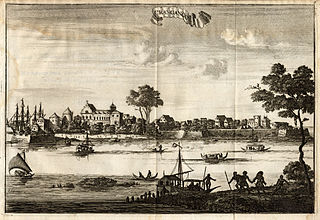
Kodungallur is a historically significant town situated on the banks of river Periyar on the Malabar Coast in Thrissur district of Kerala, India. It is 29 kilometres (18 mi) north of Kochi (Cochin) by National Highway 66 and 38 km (24 mi) from Thrissur. Kodungallur, being a port city at the northern end of the Kerala lagoons, was a strategic entry point for the naval fleets to the extensive Kerala backwaters. It was here that one of Jesus's disciples, St. Thomas reached during 1st century AD to preach Christianity.

The Kingdom of Cochin, also known as the Kingdom of Kochi or later as Cochin State, named after its capital in the city of Kochi (Cochin), was an Indian Hindu kingdom in the central part of present-day Kerala state. It commenced at the early part of the 12th century and continued to rule until its accession to the Dominion of India in 1949.

Anizham Thirunal Marthanda Varma was the founding monarch of the southern Indian Kingdom of Travancore from 1729 until his death in 1758. He was succeeded by Rama Varma (1758–98). While he was the heir to the throne, he suggested to his uncle the idea of forming an alliance with the Mughal Nawab of Carnatic. Rama Varma pledged allegiance to the Mughal empire and embraced the title of "Zamindar of Malabar". The feudatory status of Travancore persisted even during the era of Hyder Ali.

Kolattunādu (Kola Swarupam, as Kingdom of Cannanore in foreign accounts, Chirakkal (Chericul) in later times) was one of the four most powerful kingdoms on the Malabar Coast during the arrival of the Portuguese Armadas in India, along with Zamorin, the Kingdom of Cochin and Quilon. Kolattunādu had its capital at Ezhimala and was ruled by the Kolattiri royal family and roughly comprised the North Malabar region of Kerala state in India. Traditionally, Kolattunādu is described as the land lying between the Chandragiri river in the north and the Korappuzha river in the south. The Kolathunadu (Kannur) Kingdom at the peak of its power, reportedly extended from the Netravati River (Mangalore) in the north to Korapuzha (Kozhikode) in the south with the Arabian Sea on the west and Kodagu hills on the eastern boundary, also including the isolated islands of Lakshadweep in the Arabian Sea.

Malabar District, also known as Malayalam District, was an administrative district on the southwestern Malabar Coast of Bombay Presidency (1792–1800), Madras Presidency (1800–1937), Madras Province (1937–1950) and finally, Madras State (1950–1956) in India. It was the most populous and the third-largest district in the erstwhile Madras State. The historic town of Calicut was the admisnitrative headquarters of this district.

Kottarakkara, also transliterated as Kottarakara, is a town and municipality in the Kollam district of the Kerala, India. The town is close to Kollam Port, which has a rich history linked to the early medieval period as well as the reputation as an important commercial, industrial and trading center. Kottarakkara lies 27 kilometres (17 mi) to the east of Kollam city centre.
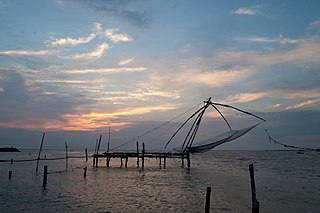
Kochi is a city located in the Ernakulam District in the Indian state of Kerala about 200 km from Trivandrum, the capital of Kerala.

Thalavoor is a village located in the district of Kollam in the Kerala state of India. It is 77 km to the north of the State Capital, Thiruvananthapuram, and 28 km to the east of District Capital, Kollam. Thalavoor village is bordered by Pattazhy village to the north, Pidavoor village to the north-east, Vilakkudy village to the south-east, Melila village to the south and Mylom village to the west. Thalavoor is a part of Pathanapuram Block Panchayat
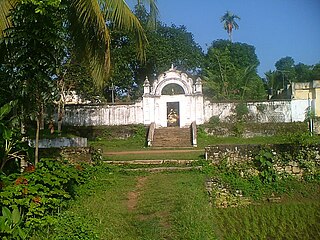
Kilimanoor Palace is a palace located in Kilimanoor, in the Indian state of Kerala. It is the birthplace of painter Raja Ravi Varma and Raghava Varma, the father of king Marthanda Varma.

Rama Varma I often referred to as Dharma Raja, was the Maharajah of Travancore from 1758 until his death in 1798. He succeeded his uncle Marthanda Varma, who is credited with the title of "maker of modern Travancore". During his reign Dharma Raja not only retained all the territories his predecessor had gained but administered the kingdom with success. He was addressed as Dharma Raja on account of his strict adherence to Dharma Sastra, the Hindu principles of justice by providing asylum to thousands of Hindus and Christians fleeing Malabar during the Mysorean conquest of Malabar.
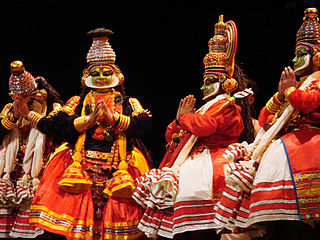
Krishnanattam is a temple art in Kerala, India. It is a dance drama and presents the story of Krishna in a series of eight plays and was created by Manaveda, the then Zamorin Raja of Calicut in northern Kerala. The eight plays are: Avataram, Kaliyamardanam, Rasakrida, Kamsavadham, Swayamvaram, Banayuddham, Vividavadham and Swargarohanam. It survives in its glory at the Guruvayur Sri Krishna temple.
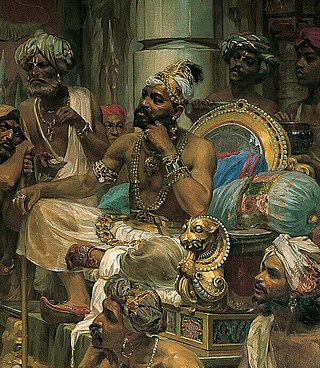
The Samoothiri was the title of the erstwhile ruler and monarch of the Kingdom of Kozhikode (Calicut) in the South Malabar region of India. Originating from the former feudal kingdom of Nediyiruppu Swaroopam, the Samoothiris and their vassal kings from Nilambur Kovilakam established Calicut as one of the most important trading ports on the southwest coast of India. At the peak of their reign, they ruled over a region extending from Kozhikode Kollam to the forested borders of Panthalayini Kollam (Koyilandy). The Samoothiris belonged to the Eradi subcaste of the Samantan community of colonial Kerala, and were originally the ruling chiefs of Eranad. The final Zamorin of Calicut committed suicide by setting fire to his palace and burning himself alive inside it, upon learning that Hyder Ali had captured the neighboring country of Chirackal in Kannur.
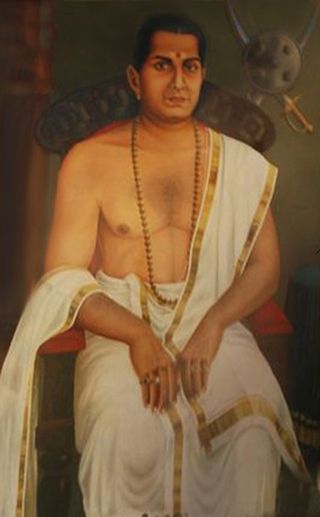
Kottayam (Cotiote) is a former independent feudal city-state, in the present-day Indian state of Kerala, in the Indian subcontinent. Kottayam (Cotiote) is famed for Pazhassi Raja, one of the principal leaders of the Wayanad Insurrection (Kotiote Palassi rebellion or Cotiote War). Pazhassi Raja was a member of the western branch of the Kottayam royal clan. When Hyder Ali of the Kingdom of Mysore Mysore invasion of raided parts of Malabar in 1773, the Raja of Kottayam found political asylum in Travancore. In 1790, the British recognized Pazhassi Raja as the head of Kottayam instead of the original Raja who had taken refuge at Travancore.
Ramanattam is a temple art in Kerala, India. The dance drama presents the story of Rama in a series of eight plays and was created under the patronage of Veera Kerala Varma alias Kottarakkara Thampuran. Ramanattom is based on a story from the epic Ramayana, covering the incarnation of Rama to the Rama-Ravana War, Ravana's defeat and Rama's crowning at Ayodhya. The story was written by Kottarakkara Thampuran and is divided into eight poetic sections so that each section can be enacted in one day. These eight sections are puthrakameshti, seetha swayamvaram, vicchinnabhishekam, kharavadham, balivadham, thoranayudham, sethubandhanam and yudham (war). Ramanattam is widely believed to be the immediate stem of the well known classical art form of Kerala, Kathakali.
Parappanad was a former feudal city-state in Malabar, India. The headquarters of Parappanad Royal family was at the town Parappanangadi in present-day Malappuram district. In 1425, the country divided into Northern Parappanad and Southern Parappanad. Southern Parappanad included parts of Tirurangadi Taluk and the town Parappanangadi. Northern Parappanad included Panniyankara, Beypore, and Cheruvannur of Kozhikkode Taluk. Parappanad royal family is a cousin dynasty of the Travancore royal family.

Manaveda (Malayalam മാനവേദന് was one of the Zamorin Rajas of Calicut in northern Kerala, and is renowned as the author of Krishnanattam. This art is a dance drama and presents the story of Krishna in a series of eight plays.

South Malabar refers to a geographical area of the southwestern coast of India covering some parts of the present-day Kerala state. South Malabar covers the regions included in present-day Kozhikode taluk of Kozhikode district, the whole area of Malappuram district, Chavakkad taluk of Thrissur district, and Palakkad district, excluding parts of Chittur taluk. The Fort Kochi region of Kochi city also historically belongs to South Malabar. The term South Malabar refers to the region of the erstwhile Malabar District south to the river Korapuzha, and bears a high cultural similarity to both the Cochin and the North Malabar regions.

















